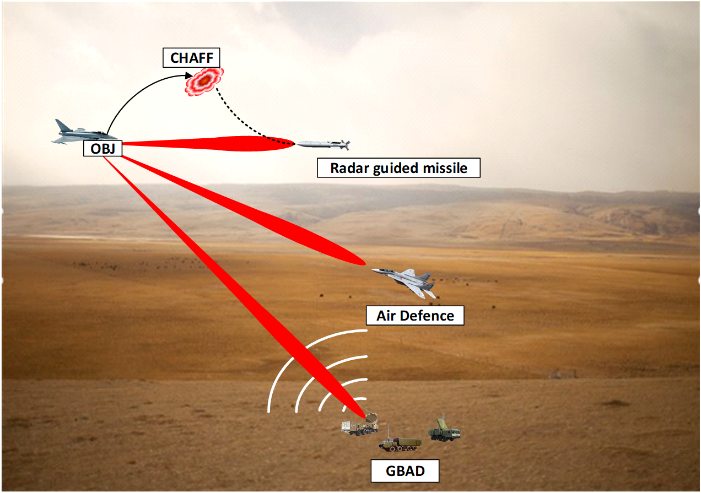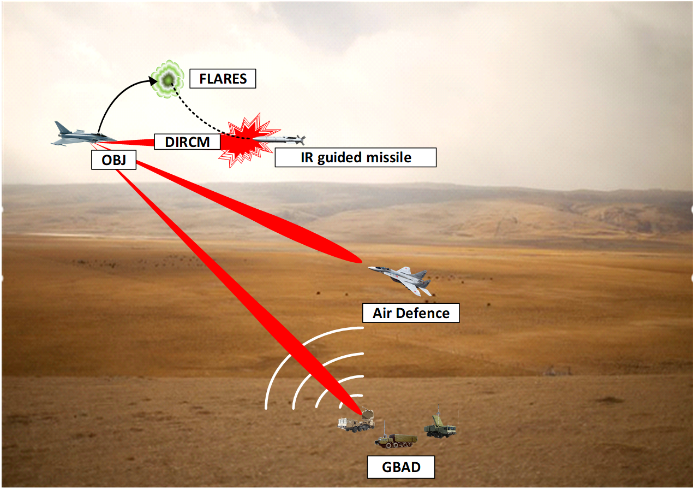Self-Protection Task (airborne)
Self-Protection Task is reactive and acting in a multi-spectral domain including the Radio Frequency (RF) and the Electro Optic (EO) domains.
This mission is performed in order to generate Electro-Magnetic signals aimed to induce wrong measurements (angle, distance) or to deny the target detection and tracking to a radar or missile seeker up to the minimum distance possible (burn-through range).
Burn-through range can be defined as the range at which the enemy’s sensors overcome the jamming effect.
If this distance is very short, the enemy weapon system under jamming will not have enough time to fire or the enemy missile under jamming will not have enough time to re-acquire the target.
To increase the survivability of the platform, the SPS must be able to detect threats, identify them, react with the shorter response time possible, and deliver effective countermeasure.
To do so the SPS architecture needs a very integrated approach inside the platform (in-platform EW integration layer) and among networked platforms equipped with SPS’s (cross-platform EW integration layer).

Figure 1: SP Task exploited with RF based countermeasures (RECM/CHAFF)
In addition, delivering RF based countermeasures (RECM/CHAFF) and/or EO/IR based countermeasures (DIRCM/FLARES) against missile seekers introduces miss distance in the terminal weapon itself, thus enhancing the survivability of our forces.

Figure 2: SP Task exploited with RF based countermeasures (RECM/CHAFF) and EO/IR based countermeasures (DIRCM/FLARES)
Self-Protection Task is performed by the Self-Protection Suite (SPS) that is installed in the platform to be defended.
SPS operates from the same platform to protect it from hostile terminal threats such as Fire Control Radars (FCR) and missile seekers before they enter in the lethal range to let the platform survive in a hostile environment.
To increase the survivability of the platform, the SPS must be able to detect threats, identify them, react with the shorter response time possible, and deliver effective countermeasure.
To do so the SPS architecture needs a very integrated approach inside the platform (in-platform EW integration layer) and among networked platforms equipped with SPS’s (cross-platform EW integration layer).
Delivering RF based countermeasures (RECM/CHAFF) against the sensor that engages our platform worsens the aiming accuracy of the Fire Control Radar lowering the hit probability of the associated weapons.
In addition, delivering RF based countermeasures (RECM/CHAFF) and/or EO/IR based countermeasures (DIRCM/FLARES) against missile seekers introduces miss distance in the terminal weapon itself, thus enhancing the survivability of our forces.
Self-Protection ECM operations use a number of ECM Techniques can be classified as Jamming (Noise/Confusion), Deception/Seduction and Multimode:
-
Jamming (Noise/Confusion): non-coherent countermeasure action based on noise transmission, whose purpose is mask, to reduce, to dilute the useful information in the signal received by the Radar with the objective of preventing or hindering own platform operation.
-
Deception/Seduction: coherent countermeasure action superimposing false information or a false signal to the true one or replacing the useful signal with a “more attractive” one with the purpose of occupying the radar receiver and processing resources to masking the platform to be protected
-
Multimode: countermeasure action combining techniques belonging to the above mentioned categories.
SPS is a combination of:
-
capabilities to receiving/processing the EMS aimed to know and control the adversary use of the EMS and
-
capabilities of generation/transmission of jamming signals to stop and/or to confuse the correct flow of information to delay or to impede the adversary decision-making process.
Key areas of technology are:
-
RF – Wide Band, high sensitivity, multi-function (sensor, effects, comms), high power, conformal.
-
EO/IR – Wide Band, multi-colour, window technologies, compact optics.







